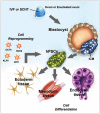Protein post-translational modifications and regulation of pluripotency in human stem cells
- PMID: 24217768
- PMCID: PMC3915910
- DOI: 10.1038/cr.2013.151
Protein post-translational modifications and regulation of pluripotency in human stem cells
Abstract
Post-translational modifications (PTMs) are known to be essential mechanisms used by eukaryotic cells to diversify their protein functions and dynamically coordinate their signaling networks. Defects in PTMs have been linked to numerous developmental disorders and human diseases, highlighting the importance of PTMs in maintaining normal cellular states. Human pluripotent stem cells (hPSCs), including embryonic stem cells (hESCs) and induced pluripotent stem cells (hiPSCs), are capable of self-renewal and differentiation into a variety of functional somatic cells; these cells hold a great promise for the advancement of biomedical research and clinical therapy. The mechanisms underlying cellular pluripotency in human cells have been extensively explored in the past decade. In addition to the vast amount of knowledge obtained from the genetic and transcriptional research in hPSCs, there is a rapidly growing interest in the stem cell biology field to examine pluripotency at the protein and PTM level. This review addresses recent progress toward understanding the role of PTMs (glycosylation, phosphorylation, acetylation and methylation) in the regulation of cellular pluripotency.
Figures







References
-
- Ciechanover A. Proteolysis: from the lysosome to ubiquitin and the proteasome. Nat Rev Mol Cell Biol. 2005;6:79–87. - PubMed
-
- Deribe YL, Pawson T, Dikic I. Post-translational modifications in signal integration. Nat Struct Mol Biol. 2010;17:666–672. - PubMed
-
- Takahashi K, Tanabe K, Ohnuki M, et al. Induction of pluripotent stem cells from adult human fibroblasts by defined factors. Cell. 2007;131:861–872. - PubMed
Publication types
MeSH terms
Substances
Grants and funding
LinkOut - more resources
Full Text Sources
Other Literature Sources
Miscellaneous

